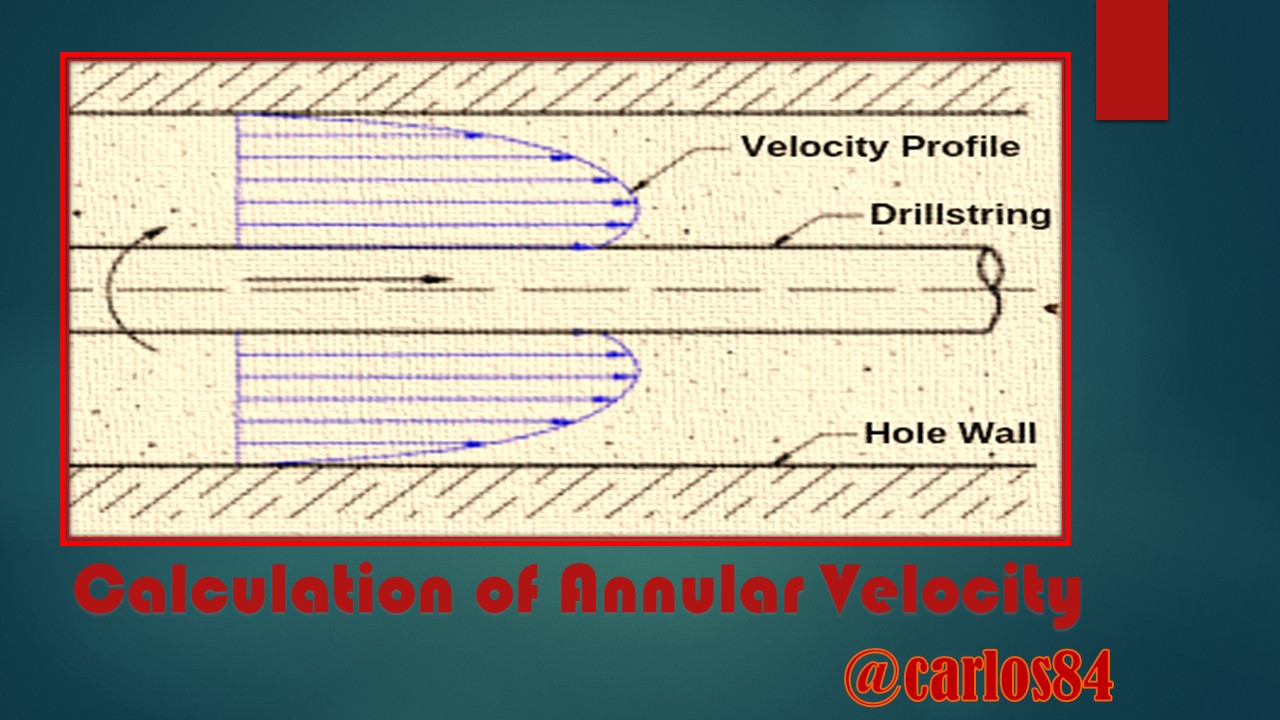How to calculate the annular velocity of the drilling fluid?

When we refer to annular velocity we refer to the velocity that the drilling fluid reaches when it circulates through the annular space of the drilled hole, this annular space is the space between the drill pipe and the walls of the hole (bare hole) or the annular space between the drill pipe and the casing (cased hole).
The importance that lies in the annular velocity calculation lies in knowing the factors that affect this calculation, for this I will explain them below:
- The size of the hole: If we take into account that the velocity that will be generated in the circulation of the drilling fluid is due to the flow rate capacity generated by the mud pumps, and if we take into account that the flow rate is equal velocity per area, then when we clear velocity we are left with what velocity will be equal to flow rate between area, the smaller the flow area, the higher the velocity, and the larger the flow area the lower the velocity.
This is the reason why the size of the hole influences the annular velocity, because if the diameter of the hole is larger, then the larger the flow area and therefore the lower the velocity will be and will have to be compensated with a higher mud pump flow rate.
Drill pipe size: The diameter of the drill pipe d is also influential on the annular velocity, since if the diameter gets larger and larger, then the volume of the annular space will be smaller and hence the annular velocity will be higher.
Pumping rate: Logically it will not matter how big or small the annular space is to adjust the annular velocity to the desired value, because if the annular velocity is too high we simply lower the flow rate of the mud pump, and if the velocity is too low then we increase the flow rate.
There is a hydraulic design where engineers perform the annular velocity calculations according to the optimal requirements in well drilling, since the circulation velocity of the drilling fluid (drilling mud) must have a minimum velocity value that is capable of allowing it to drag the drill cuttings from the bottom of the well to the surface, this with the intention of performing an optimal cleaning of the hole.
If the velocity drops below these minimum annular velocity values then drill cuttings begin to remain at the bottom of the hole, causing the drill pipe to get stuck and stop drilling completely.
It is also important to mention that the circulation velocity of the drilling fluid in the annular space cannot exceed the maximum values given by the hydraulic design, because if it exceeds them, then it could generate an undermining in the formation, which causes collapse in the walls of the hole and subsequent stop drilling.
If the annular velocity values are maintained between the minimum and maximum values dictated by the hydraulic design, then we would be talking about an optimal annular velocity.
Calculation of annular velocity in units of feet / minute

Take an example assuming a well is being drilled with a mud pump flow rate of 450 GPM and a hole diameter of 12.5 inches, the outside diameter of the drill pipe is 5 inches. Calculate the annular velocity under these conditions?

As can be seen under these conditions of pump flow rate of 450 gallons per minute, hole diameter of 12.5 inches and drill pipe outside diameter of 5 inches, the drilling fluid reaches a velocity in the annulus of 84 feet per minute.
Since it is known that while drilling, neither the hole diameter nor the drill pipe diameter conditions can be changed, then if we wish to lower or increase the annular velocity, we must lower or raise the pump flow rate and adjust it to the required annular velocity.
References
Formulas and Calculations for Drilling, Production and Workover / Lapeyrouse, 2002.
Drilling Fluids Engineering Manual, M-I SWACO, Version 2.0, 2001.
Applied Drilling Engineering / SPE Textbook Series, Volume 2, 1986
Thanks for your contribution to the STEMsocial community. Feel free to join us on discord to get to know the rest of us!
Please consider delegating to the @stemsocial account (85% of the curation rewards are returned).
You may also include @stemsocial as a beneficiary of the rewards of this post to get a stronger support.